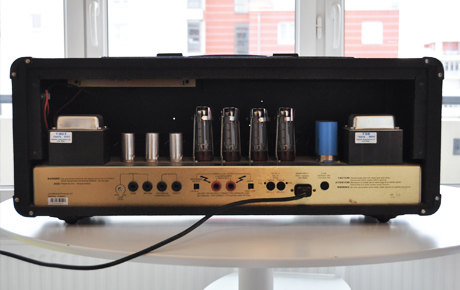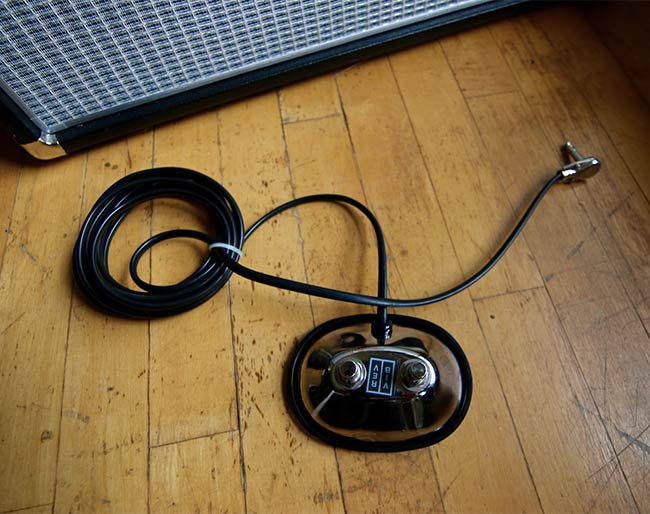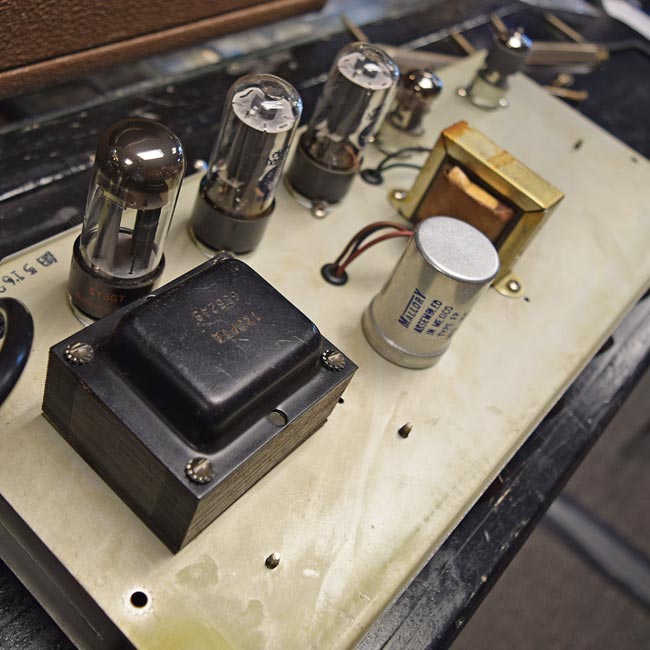Have you ever tested, or even bought, a new guitar amp that you liked except for some quibbling feature that left you wondering “Why did they decide to do that?”
I’ve encountered several puzzling design and equipment choices over my many years of exploring tube amps, and some of these have developed into full-blown pet peeves.
These observations are intended to be taken in fun, but I offer some of these as valid considerations, too. And very likely, I’m not the first guitarist to wish some of these features were presented differently. In the name of balance, though, I’ll occasionally point out my best guess at why a designer or manufacturer may have rendered said peeve-inducing feature as they did, denoted as a Devil’s Advocate position. Often, of course, it’s a game of “best choices,” and you generally can’t please all potential customers every time. With most of these, however, I feel things could be done better.
1. Can’t Get the Tubes Out
Whether you’re buying a mass-produced, offshore-manufactured model or one that was hand-built in the USA, any genuine tube amp will need to have those tubes changed at some point, whether for routine service or to tweak the tone to your own preferences. Why on earth, then, would any manufacturer make it almost impossible for a mere mortal to remove and reinstall the tubes without removing the entire chassis?
You shouldn’t have to take an amp to a qualified tech merely to change preamp tubes; in the case of some output tubes, sure, you might need a tech’s help if they need to be re-biased when being replaced, assuming you’re not able to do it yourself. On top of that, tube removal shouldn’t require extreme measures or the removal of major parts other than the protective back panel, which is an essential ingredient for safety reasons. In the ideal world, you should be able to reach the tubes without a hassle and be able to see into the sockets to ensure you are correctly lining up the pins when popping in the new tubes.

Consider any vintage Fender or Marshall amp as the standard for easy tube swapping. The tubes are lined up in a row toward the back edge of the chassis, which is very easily revealed with the removal of one protective rear panel. That’s how it should be, although I’m willing to accept that some makers have very sound design objectives in positioning their tubes elsewhere.
Devil’s Advocate Position: Matchless amps, for example, are known for their extremely high build quality and excellent tone and performance, although the tubes in many Matchless models can be a pain to access. Mark Sampson’s original design for many Matchless models involved placing the tube sockets around the chassis so that they logically fall within the flow of the point-to-point circuit, necessitating only minimal wire lengths to make the connections and, as a result in his estimation, maximizing the sensitivity and responsiveness of the amps themselves.
There are some tricks that the experienced Matchless user can employ to line up tube pins for an easy “blind fitting” into their sockets, and many would consider this lack of convenience a worthy sacrifice. Some other makers might be excused for similar reasons.
2. No Reverb Footswitch

Many makers simply dispense with it, by which I mean not only is there no footswitch, but there’s no connection for a footswitch. You engage the reverb via it’s on-amp knob only, and there’s no way to switch it on and off mid-flight.
Why would you do such a thing? Well, Devil’s Advocate might declare that most players either perform with their reverb on or off throughout the entire song or performance; therefore: no footswitch connection, which might further clutter another desired design ethos. Not being a reverb addict myself, I tend to use it as an effect rather than as an always-on tonal or atmospheric enhancement, and I’d much rather step on a footswitch to bring it in for the moodier songs that require it than trot back to my amp to twist the knob.
3. No Footswitch
If you build an amp that has foot-switchable functions, for Pete’s sake, please throw a footswitch into the box. Fender always did back in the glory days, right? Mesa/Boogie sent along a footswitch when they introduced that radical high-gain channel-switcher in the late ’70s.
What’s the Devil’s Advocate on this one? Nothing but cheapskatery, I’d say. Why leave a new customer frustrated that he or she can’t get the most out of your carefully designed amp until they’ve plonked down another little wad of cash to purchase the footswitch that they, quite reasonably, assumed was included in the first place. Go on, just include the thing.
4. Cheap Components in a Quality Amp
Sure, good amp designers often have recourse to use generic or inexpensive components in high-end designs; sometimes they are simply the right part for the job, regardless of cost, and sometimes they just happen to enhance a desired tone or performance characteristic.
That’s all well and good. But the use of an inferior part simply for lack of care or due diligence in component selection is never acceptable, and it happens plenty. That applies to an input that gets wobbly after you’ve inserted your jack only a couple hundred times as much as it does to a signal capacitor that isn’t ideal for the circuit or a speaker choice that constrains an otherwise potentially great-sounding amplifier. If your hand-wired amp costs anywhere in the ballpark of $2,000 or more, you should expect that every component in the build has been selected with a full awareness of its capabilities and considered for its specific performance within that specific circuit.
The Devil’s Advocate might reply that Alexander Dumble has been known to use Radio Shack parts in his über-expensive amps, or that Ken Fischer of Trainwreck Circuits could whip together a creation out of junkyard components that would make you weep with sonic ecstasy, but these are exceptions to the rule. Otherwise, an amp billed as “top quality” should be built as such.
5. Lack Of External Bias Points
In this day and age, any amp that requires a rebiasing of the output tubes whenever they are replaced should have convenient external bias-check points and a bias-level potentiometer right alongside them. It’s just good form, and it’s so easy to provide. Many players do their own biasing these days, and this makes the job a lot easier. Also, your output tubes’ bias ideally should be checked and re-checked some time after installation, after they have been played-in a while, and this feature certainly would facilitate that.
If I had created a tube-amp design that I was proud of, I wouldn’t want the user to have to remove the entire chassis to check the bias, or have to purchase an expensive bias probe to avoid doing so. The parts required to add built-in external bias points would cost less than $10; you still would need the correct type of digital multi-meter to get the job done, but if you’re into tube amps, you should have one of those anyway.
The Devil’s Advocate position on this one? I can’t think of one. Note, however that you can forget this point regarding cathode-biased amps (single-ended amps, or those that are nominally “Class A”, or others based on the popular tweed Deluxe circuit and the like), for which this doesn’t apply.
6. How Do I Remove the Chassis From the Cab?
Yeah, this shouldn’t happen. Even with that sticker on the back that says “no user serviceable parts inside,” the owner of any amp should be able to remove the chassis from the cab if necessary. Aside from that, it certainly shouldn’t be a struggle for any qualified tech who needs to do so, potentially costing the customer more in service fees for the extra time and effort.

Give us four bolts, perhaps a rear panel to remove first, then slide the thing out, and slide it back in again when you’re done making any repairs. Done. Fine, you might have to disconnect the speaker cable, reverb cables and perhaps even the connection to a light-up logo plate before you get in there. But you shouldn’t have to remove a speaker, reverb pan, or twist the amp or cab at some unfathomable angle to free that chassis from its cage.
Let’s look to one of Leo Fender’s founding principles: an amp should be easy to manufacture, which also means it’s easy to repair.
Devil’s Advocate Position: Maybe the manufacturer doesn’t want us amateurs getting in there and poking around. Or, perhaps the integral design of chassis and cabinet is so extremely cool and stylish that it simply requires a little more effort on the part of the owner or the tech. But I’m not buying it.
For safety’s sake, DON’T remove your amp’s chassis unless you fully understand the required safety procedures regarding the discharging filter capacitors and other matters regarding safe conduct within a tube-amp chassis.
7. Where’s the Speaker Cable?
This isn’t a point regarding design and construction as such — more service and supply — but I think it’s valid nonetheless. And yet it’s one that a surprising number of amp makers fall down on. When a customer has spent good money purchasing your amp head and speaker cabinet as a set, you could throw in a decent cable to connect the two, couldn’t you?
The Devil’s Advocate might declare that the cable is an external component, and perhaps that’s valid in the strictest sense. It isn’t something that’s made by the amp maker. But it could be, and I’d say should be. Heck, just to prevent customers from thinking they can connect the two with a guitar cable, please go the extra mile to throw in $20 worth of quality speaker cable. It’s just the right thing to do. After all, you supply an AC power cable, right? What's that? “The amp won’t function without a power cable,” you say? It won’t function without a speaker cable, either.
ABOUT THE AUTHOR: Dave Hunter is a writer and musician who has worked extensively in the USA and the UK. The author of The Guitar Amp Handbook, Guitar Effects Pedals, Guitar Amps & Effects For Dummies, The Gibson Les Paul and several other books, Dave is also a regular contributor to Guitar Player and Vintage Guitar magazines. See some of Dave's books on Reverb here.
